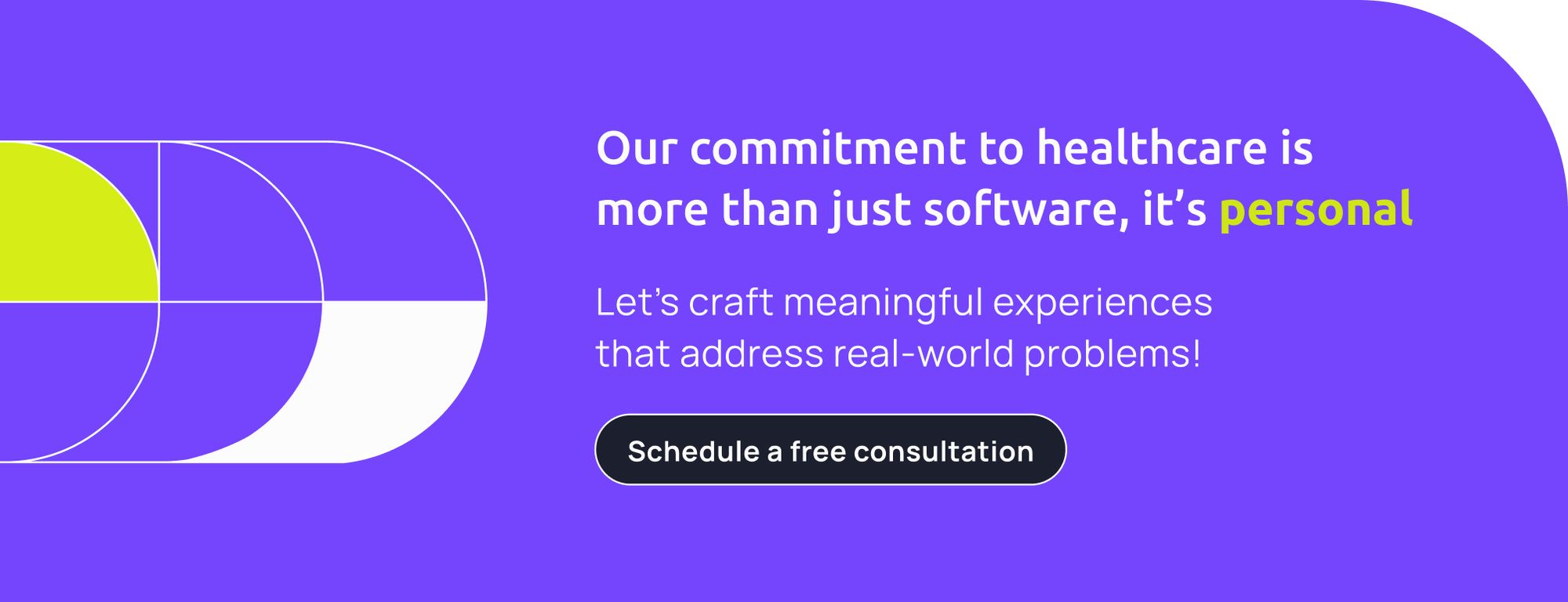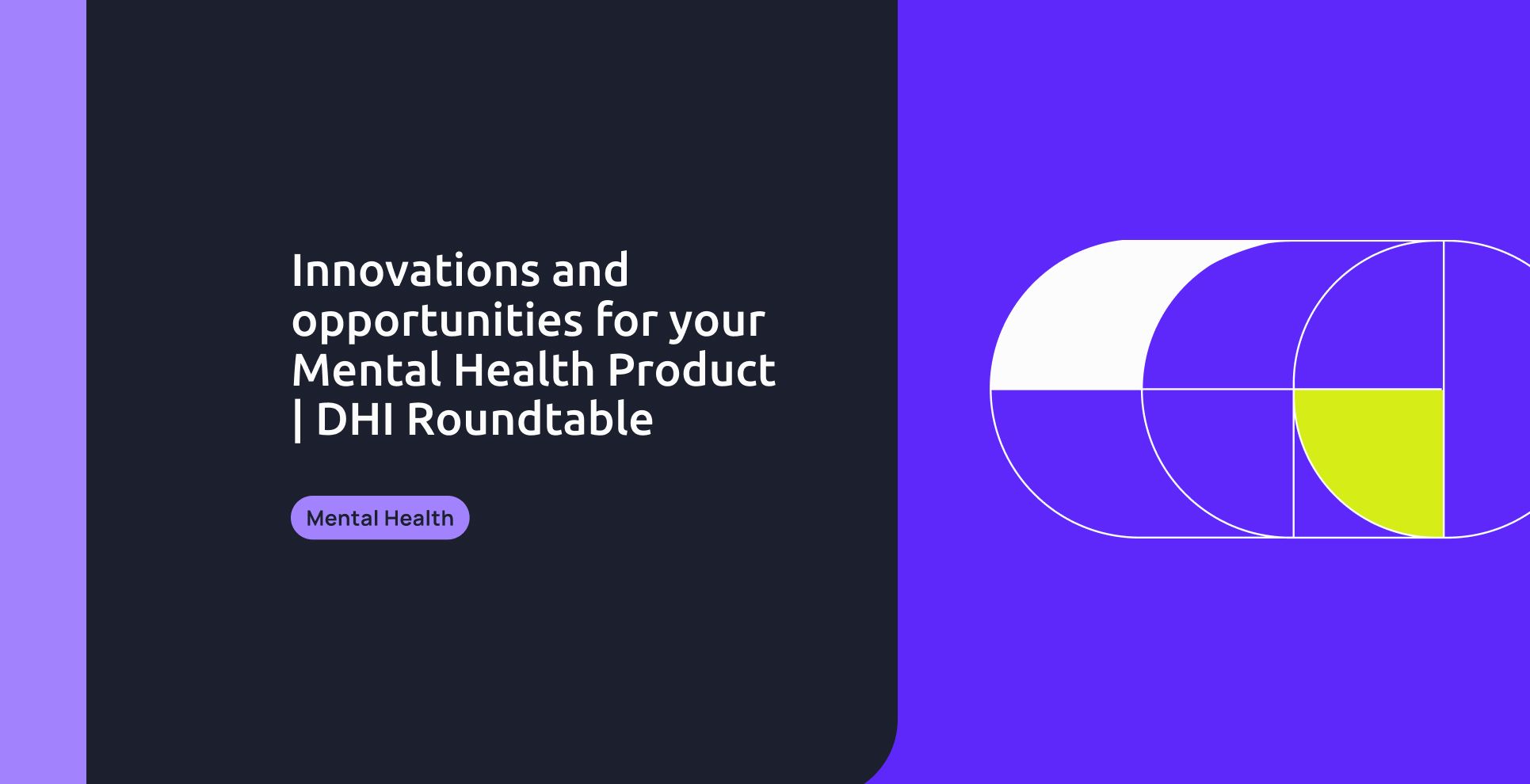Take a look at the insights from the latest mental health roundtable hosted by Digital Health Insider - a top health innovation newsletter created by the experts at Light-it. In this blog post, we'll be breaking down the main takeaways and lessons shared by industry experts. You'll discover the practical knowledge that came up during the discussions, shedding light on the intersection of technology and mental wellbeing, and how it's shaping the future of digital mental health solutions.
The panel featured diverse experts, including:
- Solome Tibebu: founder of Behavioral Health Tech, social entrepreneur and digital health investor.
- Sarah Oreck: Reproductive Psychiatrist, Therapist, and Founder at Mavida Health
- Federico Ruiz: founder and CEO of Puppeteer
- Jose Muñoz Aycart: Co-Founder and Managing Director at Wondermed.
- and Alan Brande: Founder and CEO at Light-it, as the moderator.

So, let's start and delve deep into all the roundtable discussions!
Psychiatry Stigma Evolution:
The roundtable kicked off by discussing what research suggests about the perception and conception of mental health, and more specifically, psychiatry, which has undergone significant changes in the past few years. What factors have contributed to this evolution?
Sarah Oreck reflected that there’s still a road ahead regarding mental health research: “Only recently we've done more research on the brain and are just starting to understand it. It's fascinating how far we still have to go compared to our understanding of the heart, for example, where we can describe exactly what it does and how it works”. According to the reproductive psychiatrist, there has been such extreme and incredible innovation in other areas. But the brain is the next frontier, and people are excited about what the new research will bring.
Psychiatry is a specialty that was abandoned for many years. However, many innovations and technologies are emerging. Among them is TMS (Transcranial Magnetic Stimulation). With TMS, a noninvasive technological innovation, nerve cells in brain regions linked to significant depression are stimulated by a series of brief magnetic pulses.
As stated by the speakers, COVID-19 catapulting telehealth has been incredibly impactful. “I had used telehealth before because it's incredibly supportive to people, but my colleagues didn’t quite understand it,” mentioned Sarah. Telehealth has been something that we've had in the arsenal, and it can increase accessibility so much. Sarah expressed enthusiasm about being involved in the field of digital health. She believes that digital health has the potential to bring about significant changes or improvements.
Oreck also shared that “more and more people are interested in psychiatry than they had been for like 50 years”. 'It’s the most innovative thing I've seen throughout my career!' It’s exciting to see what comes next.
The state of Mental Health Awareness and Acceptance Today
Conversations and awareness have expanded. The next generation is talking about mental health, and in that regard, stigma has reduced a bit. “But I still think there are so many questions, and unfortunately, there's still quite a bit of stigma,” mentioned Solome Tibebu, founder of Behavioral Health Tech. For example, mild and moderate anxiety and depression are areas where a lot of the stigma has lessened in the last few years. However, with substance use and severe mental illness, there's unfortunately still a ton of stigma.
All of this will be a barrier for companies that invest in mental health solutions for their employees because, at the end of the day, the employees still need to raise their hands and say, ‘I need help.’ “I still think that's a major challenge for all of us as an industry,” said Solome Tibebu.
Youth Mental Health and Their Expectations
Given Solome’s background and expertise in youth mental health, we delved into her experiences to understand which solutions raised awareness and acceptance.
“I have so much hope for this next generation, but the reality is that we are in a youth mental health crisis,” she mentioned. Being an adolescent today is extremely challenging, and at the same time, there's a shortage of specialists.
For kids and adolescents, mental health is even more dire than overall. Solome shared that this generation is ready and willing and even expects digital tools to be part of the toolbox to support them in their mental health. Thus, many youth mental health companies strongly push to develop tailored solutions for them. This is crucial because we can't just expect an adult solution to be retrofitted for the needs of young people and perform the same. “Young people have very high expectations for user experience, and it really needs to be a net new product just for them,” she explained. So, to create a product with a high user experience for teens, companies also need to understand the effective evidence-based clinical protocols that are integrated into the apps.
Mental Health Equity
We are well aware that one of the main problems is the shortage of mental health practitioners and providers. However, some populations encounter even higher hurdles when it comes to accessing mental health care. So, which specific populations and communities are facing more barriers when it comes to accessing mental health?
There is an opportunity for innovation in populations of color, seniors, and immigrants. This not only includes the implementation of technologies at the forefront of many conferences but also the chance to go into these communities and understand what they need and what has been working for them. “What is custom-built for them by them, and how can we integrate those practices into mainstream apps and technologies?”'.
In addition to all of that, Jose Muñoz highlighted a startling statistic: “75% of US counties don't have a mental health prescriber. And I think that conglomerates absolutely everybody at that high percentage.” Hence, it's important to note that telemedicine is just one of the many solutions, but much work still needs to be done to allow its access.
Trends & Innovations
The conversation moved forward, and innovation was addressed. So, with all the substantial changes that have occurred in the industry, what are some of the strongest trends emerging in the health tech and mental health space that are changing the game for patients and providers?
For Federico, the most prominent trend is AI. “I think the first thing to keep in mind here is that we're still in the early stages. It's only been one or two years since the underlying technologies, which are about to cause a real revolution in this field, came into existence,” he mentioned. He explained that we are just starting to witness the advent of large language models that are truly sophisticated and capable of holding human-like conversations. These models serve as the foundation for the kind of AI experiences that can truly change the game. Federico explained that these types of experiences will ultimately center around the ability to offer AI mental health coaches, AI therapy, and continuous at-home AI care. This includes AI support following a doctor's prescription of a specific protocol, medication, or a set of diet plans and exercises.
He affirms that what we'll start to witness in the future are conversational agents, which are not quite ready for prime time as of now. These agents will primarily be voice-based, highly accessible, and deeply conversational. They'll acquire charisma and the ability to build rapport with users, making interactions enjoyable and spanning over more extended periods — days, weeks, and months rather than just a single conversation. Currently, we observe the development of tools that facilitate the design of these conversations, adhering to specific guidelines and patterns.
“Regarding therapy, we might not be fully prepared to replace a human therapist just yet," he said. However, it's a reality that, for many individuals undergoing therapy, interactions with their therapists are often confined to perhaps a more significant one-hour session per week. And then, some sporadic check-ins in the middle—perhaps during a particularly complicated time—might lead to an impromptu session scheduled for an hour. It's this reactive approach that occurs on a weekly basis. The intriguing aspect of AI is the potential to fill in those gaps and provide a kind of 24/7 support that patients can access. This continuous availability could significantly enhance the overall support system, providing timely assistance during critical moments and contributing to a more proactive and responsive healthcare approach.
As these models and their infrastructure improve, they can provide a more sophisticated therapy. Federico continued his explanation, mentioning that using different frameworks will make it easier from an equity standpoint for people who couldn't access high-quality therapy before to at least start getting some access to it and leverage all that for their well-being. And that's just a sort of first-order effect. “I think in terms of subsequent effects, it's really hard to look that far ahead, but it's quite easy to see that the way we do therapy is going to change when you have the capacity to design a therapy that is with the user 24/7.” This means that instead of being reactive, lines are going to start to blur between being a space to talk and follow a particular therapy framework but also to doing some active life coaching on a day-to-day basis, organizing people's routines, nudging them in the right direction at the right times, intervening at particular moments in their lives. Technology will evolve rapidly, and we don’t know where it will end up, but for sure, things will change faster than any of us are expecting!
At the end of the discussion, Alan Brande, the roundtable moderator, and Light-it’s CEO, made some interesting points regarding technology in the mental health field. It does not only open new roads for diagnosis and treatments, but it also enhances things like accessibility, affordability, and even the stigmatization of mental health services. From his point of view, “the most emerging technologies like generative AI, Virtual Reality, Augmented Reality, and other types of not-so-emerging technologies like mobile and web apps are on the frontier of this space”.

Innovation accompanying mental healthcare challenges
Technology has opened new ways to make mental health better. There’s telemedicine, mindfulness apps, and AI coaches. How can these technologies enhance mental treatments?
According to Federico, doctors struggle with having patients adhere to all the protocols they have, especially over longer periods. AI companions can be really helpful in this way. Integrating this technology into the treatment can help guide individuals along treatments. For example, they can employ behavior change techniques and motivational strategies to help patients stick to treatment, enhance medication adherence, adopt healthier habits, and maintain them over time.
A great period of Federico's professional career was spent as part of Meta's VR team. When asked if he’s seen any interesting products using that technology: “I've been definitely following the literature in this space, and there are some use cases for VR that are unambiguous, they work, they're very, very effective.” The most prominent cases for him were those applying exposure therapy. For instance, individuals with a fear of heights or spiders can be placed in a safe, controlled virtual reality environment. The parameters of the environment are carefully adjusted to ensure that the individuals don’t become overwhelmed with panic but instead gradually become more comfortable with the experience.
“It's crazy. The results have just been very conclusive. And I think it's also starting to be productized by some companies. Mineco is a company using VR for exposure therapy, for smoking cessation,” Federico expressed.
It’s interesting to see how malleable our brain becomes when we can actually have full control of the input and output of it; you can control what is displayed to the user and what they hear. It’s a new sort of neuroplasticity to the brain. And it means some experiences in a regular setting might not have stuck. They do stick when you're in a VR environment.
José Muñoz finally added, "There's so many things that really wrap around the connection between mind and body that AI could help. In conglomerating millions of data points per patient at some point and achieving that precision in psychiatry, not just into what to do, but how does a patient change with the treatment?”
Patients and Providers' Disposition towards Mental Health Innovations
As a practicing physician, Sarah Oreck is more conservative about the idea of therapy being replaced in the next 10 years. But she does understand that AI can be a fantastic tool.
“You still need the human touch, but I certainly think hybrid approaches can be very helpful. I love the idea of AI helping with adherence; it can be a physician extender”.
“This's been really burdensome to clinicians for a long time.” Studies show that hospital physicians spend an extraordinary amount of time on EHRs (Electronic Health Records). “EHRs were supposed to make things easier, but in fact, many actually made work harder for physicians. They have less face-to-face time with patients,” Oreck declared. All those who do clinical work want more time in front of patients, with and caring for them, and less time documenting.
“I have to say people are hesitant on session transcriptors,” said Sarah, Mavida Health’s founder. According to her, patients sometimes feel uncomfortable knowing there is something listening to them. They are preoccupied with where this will go and where privacy is. To address this challenge, companies and professionals must be very careful and transparent in terms of explaining how AI works, how the data is handled, and how it will be guarded.
How to Prevent the Risks of AI in Mental Health
There are risks associated with applying emerging technologies, specifically AI. How can we ensure that these resources are used in the best and safest possible way?
The panel agreed that it involves learning from mistakes and applying these innovations cautiously. Be conscious that mental health conditions may, eventually and in the worst scenarios, mean suicidal intentions. It's easy to see how things can go wrong.
Federico explained: “You need the right safeguards and monitoring to ensure that whatever happens doesn't lead to a bad outcome. There must be a way for humans to be drawn back into the loop if certain events are detected.”
Puppeteer’s CEO also addressed the need to audit and regulate and to close the argument, he called for a reflection: “As a society, we have to decide what kind of role we want to give to AI agents. How much do we want to anthropomorphize something that ultimately is not a human being?”
A Non-technical Innovation: Schedule I Drugs on Mental Health Treatment
There are drugs that historically have been classified as Schedule 1, meaning drugs with no currently accepted medical use and a high potential for abuse, for example, cannabis, MDMA, and LSD.
Suddenly, some of them have become interesting for researchers, or it’s even been found that they have potential applications for psychiatric treatments. One of the biggest challenges is breaking the stigmas around these drugs for both patients and providers to prescribe them or even researchers to start experimenting with them.
According to José Muñoz, Wondermed's Co-founder and Managing director, there’s a cultural belief to break down. “There’s a philosophical dependency on the human being that when they feel sick or have a disease, there must be something that heals them.” This statement tries to explain the assumption that there “MUST” be a pill or a substance that can be taken care of to heal a condition and make it end.
The interesting and disruptive approach of psychedelic therapies is to bring the notion that the human itself is the solution. In the same way that humans and their brains are the 'problem’, we should allow the individual to understand how they can change these conditions in a more holistic manner. This approach entails a shift in lifestyle, including, for example, a healthy diet or exercise in conjunction with a change in how you balance your profession with your personal life or even in how you communicate with your close circle. These are crucial elements to dismantle the chemical dependence to enhance the perspective on which you perceive your reality.
“The perception to perspective is a transformation that psychedelics bring”, José expressed. MDMA (methylenedioxymethamphetamine), Ketamine, or Psilocybin (the hallucinogenic substance present in certain types of mushrooms) are indeed psychedelics that fall under different drug categories highly regulated by the FDA. However, when used in a controlled and safe environment, psychedelics have the power to enhance neuroplasticity, increase neuronal connectivity, and increase somebody's ability to gain a change of perspective in their life and condition.
What was previously explained doesn't mean these drugs “heal” any form of mental health condition. Still, together with a therapist, they can work through a psychological shift that effectively impacts the patient's health.
Federico made an interesting query regarding the process in which these substances work: “Is there something inherent to the dissociative state that, for example, ketamine, puts the patient through that causes improvements in their condition?” The answer: Yes, 100%. Anything that puts your mind in a different state from which you can gain a different perspective to whichever is that you're facing in life is the thing that actually allows you to get a renewed insight on how to face it, in opposition to a traditional drug dependency.
“The psychedelic approach is not based on the fact that your glutamate neurotransmitter network gets more potent,” José expressed; it’s the fact that the physiological change it imparts allows patients to gain a disassociation perspective that then grants you to see things differently.
Salome Tibebu also had an enthralling interruption: “How do we get the next generation comfortable with something so novel?”
José answered, explaining that this population is already comfortable. “It's the older generations that need to feel more comfortable because of the skepticism building around it for generations. It's a matter of giving the users information.”
According to Wondermed’s co-founder, scientific records show that psychedelic substance effectiveness is proven while undergoing mental treatments.
From a more philosophical point of view, “The realization of its potential, I think, is the core of education to believe what's possible,” José expressed, “if we change that narrative alone, I think a lot of people are going to start feeding into a different loop of thinking automatically.”
Women's Mental Health: an Under-fund Field
To continue the conversation, the subject shifted to address the gap in scientific research investment and funding on women's mental health. “Why is it that traditional protocols for conditions such as PPD (Postpartum Depression) are not comprehensively developed?” Alan, the panel’s moderator, questioned Sarah Oreck.
In response, Mavida Health’s founder explained that women's mental health has not been an area in which research investment and funding sufficiently: “Even though we're high utilizers of healthcare, maybe it's certainly more than men in the US.” She explained that this has left us in a situation where we don't know much about our bodies or what's happening with them.
Apart from this funding gap, new drugs to treat these women’s mental health conditions at or after pregnancy are emerging. In particular, there has been a breakthrough with a novel medication called Zuranolone.
This new drug consists of an active neurosteroid. Neuroactive steroids, whether originating internally or externally, swiftly modulate neuronal excitability by engaging with ligand-gated ion channels and other receptors on the cell surface. “This entails a completely different mechanism, hormonally based, um, that treats postpartum depression… Three days of taking this medication, and there's an effect. You only have to take the medication for two weeks”. Unfortunately, there is also a super-challenging fact regarding this groundbreaking drug: it's estimated to cost $16,000. This clearly brings the accessibility problem to the table, not only regarding patients but also insurance coverage. That's one of the main challenges with innovation, it may be revolutionary but either very expensive.
Final Tips by Experts to Health Tech Founders
Considering the vast experience of Solome Tibebu, Behavioral Health Tech Founder in mental health entrepreneurship, it was therefore worth asking her what would be her main recommendations for entrepreneurs in this industry.
What tips can you give health tech founders who may be listening to this roundtable and are trying to get payer coverage for their innovative solutions, uh, actually to get it?
“Having the specific communities be involved with the development of the solution, whether that's a pregnant woman, youth, or whomever, is only going to make the solution more successful, and ultimately with payer partners,” she expressed.
According to Solome, co-developing with the payer is also critical. “If they're co-developing with potential payers, they become more sympathetic to the affected population, committed to the product's success, and can offer some feedback”.
Developing those relationships from an early developing phase is eventually the biggest piece of advice on that front. This point of view is interesting and clearly very fruitful. Because it doesn’t consist of coming to the payer with a ready solution in which they have not participated and may have questions about your approach. Their doubts have surely been evacuated and addressed during the process, and that breaks down barriers at the time of seeking funding.
Mental Health Roundtable Wrapped Up
DHI’s end-of-year roundtable discussion on mental health, featuring a diverse panel of experts ranging from psychedelic medicine to emerging technologies and entrepreneurship, provided a comprehensive exploration of cutting-edge approaches and insights. The collaborative exchange illuminated the nature of mental health care and underscored the importance of integrating various perspectives and innovations to advance the field. As we move across the junction of traditional and groundbreaking mental health methodologies and therapies, the shared expertise points toward a promising future where a holistic and tech-driven approach may offer unprecedented support for mental well-being.


